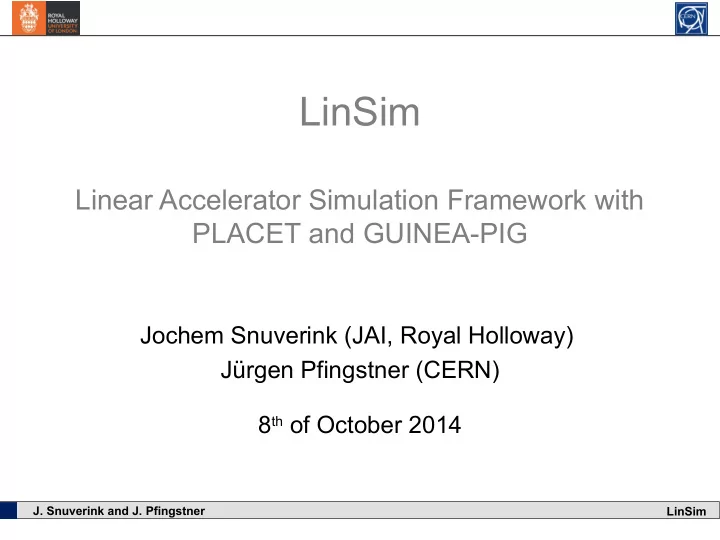

LinSim Linear Accelerator Simulation Framework with PLACET and GUINEA-PIG Jochem Snuverink (JAI, Royal Holloway) Jürgen Pfingstner (CERN) 8 th of October 2014 J. Snuverink and J. Pfingstner LinSim
Content 1. Introduction 2. LinSim 3. Examples 4. Conclusions J. Snuverink and J. Pfingstner LinSim
1. Introduction J. Snuverink and J. Pfingstner LinSim
Motivation • Very good tools (PLACET, GUINEA-PIG) and lattice repositories are used in the section for simulations on ILC/CLIC and other linacs. • However, several things are not automatized and are repeated by everybody: – Lattice and beam setup – Implementing simulations, which all have very similar structure – Debugging of code – Parallelization of simulations on a cpu-farm – Data storage and analysis – Backup and version control of complex simulations • This causes that - Several versions of very similar code exist - Many versions are not up to date anymore after interface changes - Similar tasks are repeated by many people - Newcomers and external people have a hard time to get started J. Snuverink and J. Pfingstner LinSim
Advantages of a general simulation framework • Layer on top of the simulation tools that eases complex simulations. • Lattice and beam setup is automatized. • Most code only has to be written once (e.g. imperfections). • Well debugged code. • Features can be implemented that are too much effort for a single simulation (e.g. backup including versioning system) • Data storage, parallel computing and analysis can be largely unified by providing tools. • Increase in productivity J. Snuverink and J. Pfingstner LinSim
2. LinSim J. Snuverink and J. Pfingstner LinSim
Features • Lattice and beam setup for: CLIC, ILC, FACET, ATF2. • Flexible simulation structure to implement most simulation scenarios efficiently. • Many imperfections, feedbacks, steering algorithms are provided. • Scripts for • Parallel computing on lxbatch (CERN batch computing service) • Data analysis tasks in Python and Octave (Matlab-compatible language) • Documentation (work in progress - nearly complete). • Consistency checks for settings and settings saving to reproduce results. • Version control via svn • Automated nightly testing (to be implemented). J. Snuverink and J. Pfingstner LinSim
Internal structure • LinSim interfaces PLACET and GUINEA-PIG via Tcl (mainly setup) and Octave (rest) scripts. • Also external data are used: lattice files, ground motion models, reference orbit, … • Input files control the behavior of LinSim fully. J. Snuverink and J. Pfingstner LinSim
Simulation structure 1/2 • Simulations are structures into four parts: 1. Initial setup: Lattice and beam creation, settings loading 2. Short-term loop: pulse-to-pulse simulations 3. Long-term loop: simulations on longer time scales 4. Seed loop: For statistical averaging many “machines” • Simulation consists of two parts 1. LinSim base code 2. Two test files that control and extend the simulation: • Settings file (in Tcl) • User code file (in Octave) J. Snuverink and J. Pfingstner LinSim
Simulation structure 2/2 J. Snuverink and J. Pfingstner LinSim
Variable definition • Universal variable names are used in LinSim • To be able to port code between accelerators • Quickly writing simulations • Example: • BPM readings (bpm_readings) • Element indices (index_qd0) • Beamline names (“electron”, “positron”) • … • Complete list in the manual J. Snuverink and J. Pfingstner LinSim
3. Examples J. Snuverink and J. Pfingstner LinSim
Example 1: QD0 roll scan (CLIC) 1/2 qd0_rollscan_settings.tcl qd0_rollscan_code.m J. Snuverink and J. Pfingstner LinSim
Example 1: QD0 offset scan (CLIC) 2/2 Start simulations in PLACET: placet run.tcl tests/qd0_rollscan_settings.tcl Result of analysis: Data analysis in Python: python import TrackingAnalysis a=TrackingAnalysis.MeasurementStation(director y="../QD0_rollscan/”) a.lumiScanPlot(-100,100,25,label='QD0 Roll scan [$\mu$rad]',plotname='QD0Roll’) J. Snuverink and J. Pfingstner LinSim
Example 2: Response matrix calc. with ground motion influence (FACET) 1/3 • Studies the influence of ATL motion on the measurement of the response matrix after one hour. • During the measurement ground motion of model B is used. • Initial normal distributed misalignments are applied. facet_response_matrix_settings.tcl J. Snuverink and J. Pfingstner LinSim
Example 2: Response matrix calc. with ground motion influence (FACET) 2/3 facet_response_matrix_code.m J. Snuverink and J. Pfingstner LinSim
Example 2: Response matrix calc. with ground motion influence (FACET) 3/3 First response matrix: Start simulations in PLACET: placet run.tcl tests/facet_response_matrix_settings.tcl 3 Example of seed scan on lxbatch (on AFS): cd jobs ./submit_jobs_seed_scan.sh tests/facet_response_matrix_settings.tcl 8nh 1 20 J. Snuverink and J. Pfingstner LinSim
How to get LinSim? • PLACET and GUINEA-PIG (if beam-beam is calculated) need to be installed. • LinSim is included in a larger svn repository. It is easiest to check out the full CLIC directory with svn co svn+ssh://[username]@svn.cern.ch/reps/clicsim/trunk/LinSim • If also other accelerators are simulated also the according directories have to be checked out. But not all files are necessary (see the documentation). • Documentation is located in LinSim/doc/Framework_doc.pdf. J. Snuverink and J. Pfingstner LinSim
4. Conclusions • A framework for linear accelerator simulations was presented • A layer on top of PLACET and GUINEA-PIG • It provides scripts and algorithms for complex simulation tasks • Especially useful for newcomers Not something complete! Everybody is welcome to suggest and implement. For any help/questions, please contact us! J. Snuverink and J. Pfingstner LinSim
Thank you for your attention! J. Snuverink and J. Pfingstner LinSim
Recommend
More recommend